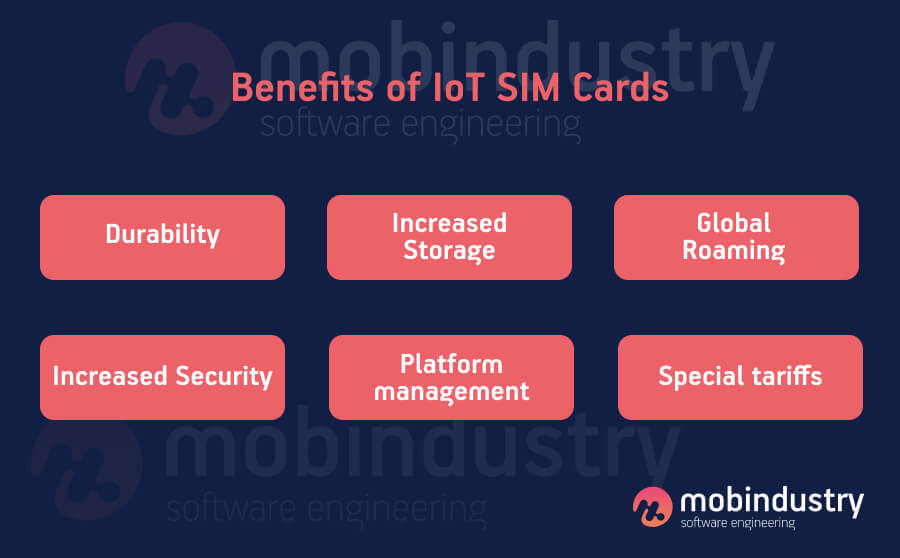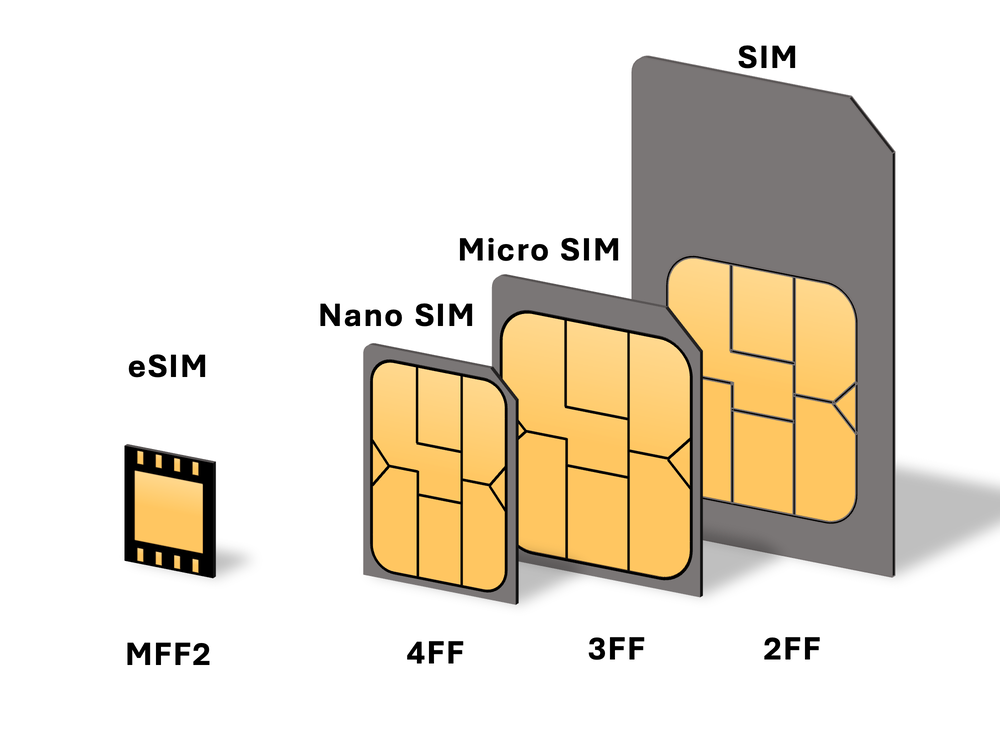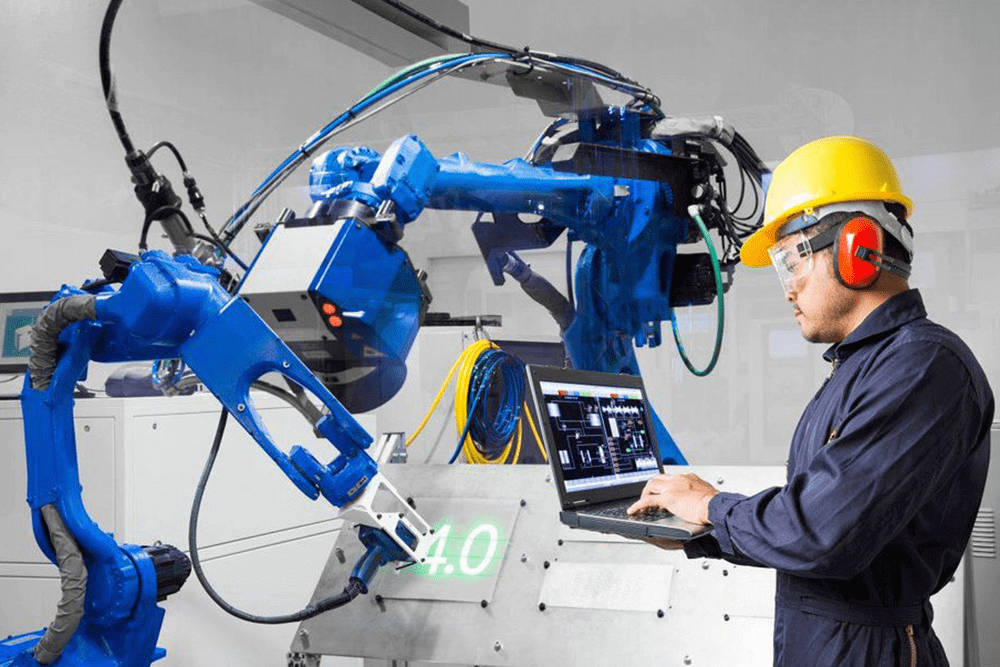IoT SIM Cards: Technology Overview and Use Cases
Connectivity is the most important aspect of the Internet of Things ecosystems. Countless protocols and connection methods unite thousands of IoT devices in a single ecosystem. IoT SIM cards are one of the most effective ways to build a large network of connected devices.
What is an IoT SIM Card?
IoT SIM cards, aka M2M SIM cards (machine-to-machine), are used in connected devices in large IoT systems that work together from different places worldwide. They connect to mobile networks of all kinds, from 2G to 5G, across different carriers, without changing the SIM cards for different regions and countries.
Another term used interchangeably with the Internet of Things SIM is UICC (Universal Integrated Circuit Cards). They possess an international identification number that works for a particular device anywhere in the world. The UICC cards carry credentials and security keys that identify the cellular subscription.
IoT SIM cards are designed to work worldwide: their data plans cover dozens if not hundreds of carriers and networks around the world, so your devices can stay connected regardless of location
This type of card can store multiple IMSIs on a single profile, giving you access to dozens or hundreds of networks worldwide. This allows you to connect your IoT devices regardless of location and choose from multiple networks to get the best coverage and efficiency.
The IoT data plans are often standardized, so you pay a fixed amount no matter what network you’re using.
This type of SIM card is often used in IIoT. Let’s explore what that is.
The difference between IoT and IIoT
IoT, or the internet of things, is a technology that connects devices within one system and allows them to communicate with each other according to automatic algorithms that don’t need manual control.
The IIoT is the Industrial Internet of Things — a subtype of IoT used for industrial applications. Usually, IIoT systems are larger in scale and more complex. They also require increased security because they often deal with sensitive data.
Let’s talk more about the use cases of IoT SIM cards and the devices that support them so that you’re more prepared to create an IoT mobile application.
What’s the difference between traditional SIMs and IoT SIM Cards?
At first glance, Internet of Things SIM cards are very similar to traditional SIM cards. They have similar features and multiple form factors, but there are more differences than similarities.
The application for these SIM cards is the biggest difference: standard SIMs that we use go into our smartphones and tablets and allow us to connect through a particular carrier.

On the other hand, their Internet of Things counterparts are used by various industries in IoT development to connect devices across large territories that sometimes exceed country borders. So, here are the main factors that differentiate IoT SIM cards from traditional SIMs.
Durability
IoT devices for industrial use often operate in harsh and even hazardous environments, and their every part needs protection from the elements. The SIM cards inside are no exception — they’re made of more durable materials and can last up to 10 years.
Increased storage
Industrial IoT devices often operate in remote locations, and regular data removal isn’t an option. That’s why, their cards have increased storage capacity compared to traditional SIM cards.
Global roaming
Large IoT systems often exceed country borders and still need to send and receive
data to the hub and each other while in other countries. IoT SIM cards can work with multiple operators across multiple countries with a single package and standardized tariffs to ensure cross-border connection.
Increased security
IoT SIM cards use various technologies to increase IoT security, like APNs and private access points to separate their data flow from the rest of the data traffic carried out by an operator.
Control through platform
Because each device is part of a bigger ecosystem, all cards are controlled and managed in a single place. Such platforms are called CMPs — Connectivity Management Platforms.
Special tariffs
Carriers offer tariff bundles of IoT SIM cards that include roaming and data volumes. Bundles allow you to distribute the data volumes across all your devices, and if one device hasn’t used all of its data, it can be passed on to another device. This helps IoT systems to be more cost-efficient.
What are the examples of IoT devices
IoT SIM cards are present in wearables, smart homes, medical or industrial devices — you name it. Here’s the list of domains that often use SIM cards for their device connectivity and examples of these devices.
- Utilities — smart valves, solar panels, tablets for employees, electricity poles, wind turbines
- Healthcare — medical equipment, wearables, drug dispensers
- Retail — POS terminals, smart shelves, vending machines
- Government sector — air quality sensors, doors, parking spaces, security cameras, signs, billboards, lights, garbage cans
- Real estate — smart homes, smart locks, thermostats, home cameras, media devices, kitchen appliances
- Logistics — trucks, cars, buses, trains, subways, EV charging stations
- Manufacturing — vehicles, factory equipment, wearables for staff, warehouse equipment, containers
- Agriculture — farming equipment, smart valves and irrigation systems, tractors, livestock, thermostats, and sensors for greenhouses.
As you can see, many industries can benefit from using IoT SIM cards. Their Internet of Things systems cover large territories and need to connect while being far from each other, sometimes even in different countries.
IoT SIM Card form factors
IoT SIM cards’ sizing and form factors are the same as those of traditional SIM cards we use on our phones and tablets. These are the common form factors for IoT SIM cards:
- Mini-SIM or 2FF: 25mm x 15mm
- Micro-SIM or 3FF: 15mm x 12mm
- Nano-SIM or 4FF: 12.3 x 8.8mm
The 3FF and 4FF are currently the most popular form factors for SIM cards. However, even the smallest nano-SIM isn’t always practical for IoT devices, especially for wearables and small sensors. This is where embedded SIMs come into play.

Embedded SIMs or eSIMs are small chips that are preinstalled onto circuit boards. They aren’t swappable as opposed to usual SIM cards. So, how can you change them?
Embedded SIM cards can be assigned to a device virtually. This means that an eSIM is programmable and can work as a card from any operator that supports eSIMs.
The most common form factor of an eSIM is MFF2, sized at 6x5mm.
IoT SIM Card use cases
You already know that IoT SIM cards are used across all industries, from retail and smart homes to agriculture, healthcare, and IoT for sustainability. Let me give a few real-world examples of how they can be used in particular domains.
Healthcare
Wearables
Wearables use IoT SIM cards to track patients’ health wherever they are. This is especially useful for people with chronic diseases such as diabetes. IoT SIM cards allow devices to track vitals like heart rate and blood pressure without depending on a Wi-Fi connection.
Health monitors
IoT SIM cards can help physicians and doctors receive health data from patients consistently and at any time, ensuring a stable connection. This is vital in critical situations where every second matters.
Manufacturing
Robots
Manufacturers can benefit from integrating Internet of Things SIM cards into their robots so they can be connected in a single network across various manufacturing sites worldwide. This will allow maintaining connection even in remote locations instead of relying on the internet.

Predictive equipment maintenance
It’s much easier and cheaper for manufacturers to fix equipment issues before they cause problems. Each second of downtime results in hundreds of thousands of dollars in losses, so monitoring the health of all systems and mechanisms is vital.
IoT SIM cards can be embedded into sensors attached to the equipment and alert staff when they detect changes in work speed or efficiency. Internet of Things devices can also track work time and remind staff about regular checkups.
Retail
Cashierless checkout
Not having to stand in line and wait for a cashier sounds like a dream. Amazon is the first company to make this a reality with their Amazon Go stores, where you can simply walk out with your purchases, and the system will automatically charge your card. Smart shelves with product trackers and smart cameras with facial recognition make this magic work.
Inventory and product management
Various trackers can help retailers track their products across multiple warehouses, predict demand, and evaluate the condition of the goods. All this helps manage products, know when to order more, and how to move products between stores and warehouses to reduce waste.
Agriculture
Predictive agriculture
Agricultural facilities are spread miles away, and it’s important to keep all the devices connected in places often covered poorly by high-speed internet connections. IoT SIM cards help to tie all sensors together, and paired with smart AI data processing, they can help farmers determine the best time for harvesting, planting seeds, and irrigation.
Drones and robots
Drones that spread pesticides over miles and fields can always stay connected through cellular networks. The same goes for robots that help harvest, seed, water, and detect plant disease early.
Logistics
Predictive delivery
Logistics companies deliver goods by air, sea, and land; the logistics network is usually too broad to rely on just the internet connection. A system of IoT SIM card-powered trackers can help businesses track transport, manage routes and predict delivery time.
Inventory and supply management
IoT SIM cards can help track the warehouses’ assets, products, and goods and calculate the supply vs. demand in particular locations using current and historical data.
Final thoughts
There are countless ways to use IoT SIM cards in your business. They are particularly useful when your operations rely highly on connection and you can’t afford to depend only on internet communications.
With this technology, you can build large and efficient ecosystems that will work worldwide on cellular connections and provide timely data no matter where you use them.
If you plan to build an IoT network for your business, don’t hesitate to contact us. We have experience building ecosystems for car and scooter-sharing businesses, sport-related equipment, and logistics companies.

